Columns
Rohingya refugees fall from Burma’s pan of terror into Lanka’s fires of hate
Forget their race, forget their creed and forget that they were born as Muslims in the land of Buddhist Burma, now Myanmar. Just hold them in your hearts for awhile as human beings, as victims of circumstances beyond their control, as innocent sufferers of another’s wrong, a nation’s crime, who must now cry in pain and bleed with grief; and storm heaven and verily raise the question, ‘ why me, why us, what grievous wrong have we and our children done on this earth this birth to deserve this terrible fate?
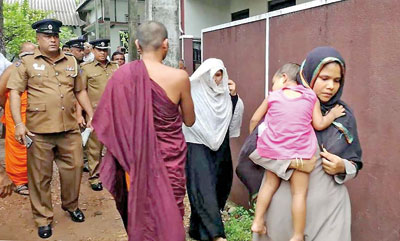
MODERN DAY SINHALA CHIVALRY: Monk mob threatening Rohingya women and children who sought Lanka’s alms of temporary refuge
On April 30th, the Sri Lanka Coast Guard craft patrolling the Indian Ocean waters off Trincomalee found 16 children, 7 women and 7 men huddled aboard a fishing boat. They belonged to a race known as the Rohingyas, a minority tribe successive Myanmar Governments had refused to recognize as an indigenous race, persecuted them without pause, and had now unleashed a systematic campaign of terror which the UN had condemned as ‘ethnic cleansing’.
They were the innocent civilian casualties caught up in a conflict not of their own making: forced to flee their burning villages in fear of their lives and their children’s lives, abandon their homes in fright to face a dark fearful future unknown. And carried with them naught but the only wealth they possessed: their lives and their children. They had endured the terror in their ghettoes of fear, where danger sprung from every government sewer and the swish of the machete slash could be heard cracking the silence of the night, followed by the death wail of a neighbour being hacked to death.
They had braved the perils of the sea, faced the tempests that brew in the Bay of Bengal and dared the gulfs to swallow them purely to flee the Myanmar Government’s military crackdown against their indigenous race; and seek refuge on some safe shore. Perhaps, they never even intended to come to Sri Lanka and had set their sails to some other shore; but, merciless fates, as they sometimes mockingly do to those in dire straits, may have directed some foul wind to blow their fishing boat to bob adrift off Trinco’s coast when the coast guard naval vessel arrived to their timely rescue.
The Sri Lankan Navy handed these unfortunates to the Mirihana detention camp. The Colombo office of the United Nation Commission for Human Rights (UNCHR) soon intervened and obtained a court order and secured their release. They were then taken and placed in a UNCHR safe house in Mount Lavinia pending repatriation to a third country.
 Procedure had been followed to the letter. From the navy taking these 30 refugees from their fishing boat and handing them over to the Mirihana detention centre to the UNCHR intervening and obtaining a court order to secure their release and temporarily sheltering them until a country could be found willing to accept these 16 children and their parents. It has even been reported that one woman refugee had given birth during this period.
Procedure had been followed to the letter. From the navy taking these 30 refugees from their fishing boat and handing them over to the Mirihana detention centre to the UNCHR intervening and obtaining a court order to secure their release and temporarily sheltering them until a country could be found willing to accept these 16 children and their parents. It has even been reported that one woman refugee had given birth during this period.
Even though they may have experienced every day their ever present trauma, reliving the nightmare of the horrors they had lived through in Myanmar, every time – five times a day – when they fell on their knees and prayed facing west in the direction of Mecca, no doubt, they would have thanked their Almighty Allah for setting the sails of their fishing vessel and steering their boat to stumble upon serendipity’s safe shore, where a gallant navy, a just court, concerned local UNCHR officials and a compassionate people guaranteed them peace of mind; and assured them that their temporary sojourn in this thrice blessed island of Theravada Buddhism would be safe.
But then this Tuesday, the bottom fell off their cherished hopes and revealed that, though 99. 9 percent of the nation’s Buddhists follow or strive to follow the Buddha’s teachings, there’s that one rotten iota that threatens to make the rest turn mold.
On 26th September, even as former president Chandrika and her sister Sunethra Bandaranaike were laying floral wreaths to commemorate the 59th anniversary of their father’s death, the founder of the SLFP and former prime minister S. W. R. D. Bandaranaike who, blood swathed and in excruciating pain after being fatally shot at his Rosmead Place residence, when asked as to who shot him had the exquisite presence of mind not to refer to his assassin as a Buddhist monk but to say with gasping breath ‘ it was a man in robes’, a few monks – or men in robes, SWRD would have called them – gathered around a house down Templar’s Road in Mount Lavinia.
They belonged to a new grouping of Buddhist monks called the Sinhale Jathika Balamuluwa which had come into existence only last year. Their slogan: Sinha-le. Like a poisonous deadly dapperling mushroom – Lepiota brunneoincarnata – they have sprouted from the compost pile of Lanka’s recent mire. And to make their mark in the morning’s paper and carve a niche of their own in the annals of face books, they displayed to the full the chivalry of Sinhala chauvinism by intimidating 16 children and seven mothers and seven men — Burmese refugees who had fled the homes in terror to meet terror again at the hands of a few monks.
And the head priest himself, no less, was present in person, to grace – or disgrace – the occasion with his saffron robe and to display to what extents men in robes could use the saffron shroud and stoop to blotch and taint, to blacken and tar the sacrosanct respect it invokes in a human heart. If you have heard of lay people looking up and spitting, this was a prime time example of a few monks groveling in dung and smearing in earnest the respect and worship the people accord them – not for the man but for the robe. Shorn of the accumulated respect it had earned though the ages by the venerable monks of old, these rabble rousing ragbag would be stripped in public and exposed; revealed as scarecrows dressed in a turmeric shroud to ward of crows.
And by their actions – how can one claim to be a Buddhist let alone a monk, if one not only fails to practice the sublime truth of Compassion towards the unfortunate but actively encourages others, too, to join one in attacking the discriminated – they effectively and conclusively demonstrated they had not only taken leave of the senses but had taken leave of their right to wear the robe of the truth seeker and were fit only to don the horns of the caricatured devil in cartoons.
Even as a Saville Row bespoke double breasted suit made in the best of British wool does not make one a gentlemen neither does a saffron robe make one a Buddhist monk. As President Sirisena asked in New York this week at New York’s Sri Lankan Buddhist Temple, “Who is a Buddhist monk? Anyone can go to a shop and buy a robe and an atapirikara, and dressed thus people will worship him as he walks the streets, but does that make him a Buddhist monk? Or is it the qualities that he possesses that make one a monk, worthy of reverence?”
It’s a tragedy of our times that certain monks have chosen to exploit the sacrosanct respect people have for the robe, and have chosen to prostitute it for illicit political gain in the self same manner a tart on twilight street would hitch her mini skirt an inch higher to attract custom.
But a fervent appeal must be made to these misguided monks not to take advantage of their blessings. Not to bring contempt upon the robe which invites the laity’s respect and fills their bowls with alms. If not for the robe, they would end up as nothing more than beggars on the street without a Dhamma to preach for their mid day meal. Do not disparage, do not reduce to ridicule and contempt the noble compassionate philosophy of the Buddha which had so moved the world for over two thousand five hundred years – which had so moved India’s greatest emperor Chandasoka to turn Buddhist and become Dharmasoka after seeing the tranquil countenance of a young Buddhist monk. That serene sight so moved him to renounce his title as King of Violence and seek re –coronation as Emperor of Peace.
If the sight of that young monk, garbed in the same sparse robe the Buddha had worn two hundred years before, moved so ruthless a king to renounce his ambitions of further conquests and to sheath his conquering sword forever; and, instead, to repose in his remorseful heart the sublime perfumed fragrance of the Buddha’s doctrine of non violence to any living being on earth – for whatever reason – if the sight of the saffron robe the Buddha wore had moved Emperor Asoka to send his son Arahant Mahinda to Lanka and carry with him the philosophy of the Buddha tucked in his begging bowl and offer it to Lanka’s King Devanampiyatissa as India’s greatest gift to this island nation – what would you say the presence of a saffron robe conveys today?
Today, the presence of a man in saffron robes outside the door does not evoke serenity but invokes fear in the downtrodden people’s heart, people who need compassion most. And, like a motorist, often irked by an errant driver on the road, shouts through his shutter, ‘who gave this fellow license to drive,’ one has come to the point when one must ask “who gave these men in robes, upasampada?”
Who are the Muslim Rohingyas? And what are they fleeing from?The Rohingyas have been the stateless nomads of South Asia for centuries and have been described as the most persecuted race in the world. If the Jews once claimed title to that dubious accolade, its time they took a back seat.For, unlike the once similarly persecuted Jews whose biblical status as the chosen seed served in the end to make them outcasts but whose accumulated wealth, earned through trading skills, brought them power and ultimately won them a state of their own, the Rohingyas had none to boast of except their badge of poverty, which made them the most forgotten people of the world: and, in turn the most persecuted. 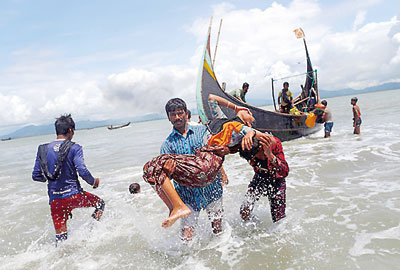 Human Tragedy: Braving perils to reach safe shore. Reuters And if they did not happen to make the news after Myanmar’s military state turned its guns on them and made them flee the persecution, they would have remained so in the eyes of the world. But a state sponsored campaign of terror, which has raised allegations of ethnic cleansing, has placed their plight firmly in the international spotlight. Since 1970 a mass exodus of Rohingyas has been taking place with hundreds of thousands fleeing discrimination and sporadic violence to neighbouring countries mainly to Bangladesh. In 2012, from the debris of the Rohingya people’s fate, there arose from their midst a terror organization, The Arakan Rohingya Salvation Army or known as Harakah al-Yaqin , the Faith Movement. Their resort to terror as their weapon to win their rights had resulted in the backlash. Here is a brief litany of their actions as reported by Britain’s BBC:
In October 2016 nine police officers were killed by armed men, believed by officials to be Muslims. Amid the ensuing violence, as Britain’s Guardian newspaper has stated, 87,000 Rohingya Muslims fled to Bangladesh and government troops expanded their presence in Rakhine state, the homeland state of the Rohingyas. On August 25th, the Arakan Rohingya Salvation Army (ARSA) struck again. They attacked government forces. In response the Myanmar army hit back. A clearance operation was launched. As the world press reported more than a thousand people were killed in the backlash. More than 300,000 were forced to flee their homes. The UN’s top human rights official Zeid said on 11th September, the military’s response was “clearly disproportionate” to insurgent attacks and warned that Myanmar’s treatment of its Rohingya minority appears to be a “textbook example” of ethnic cleansing. But the politics of Myanmar need not concern us now. At least for the moment; and for the purpose of the issue at hand. To use international diplomatic jargon, we need not interfere at this time in the internal affairs of a sovereign Myanmar. Suffice to say, it was this UN labeled ‘ethnic cleansing’, that these 30 refugees were fleeing from. And they sought refuge in our home and, whilst this nation invited them in, even as 55 of them were embraced with hugs in 2008 and over 155 were kissed on both cheeks during the Rajapaksa regime and repatriated when a third country willing to accommodate them was found and not a murmur of protest was heard then, it is deplorable to see scenes of ignorance clad in saffron shrouds spout hate upon those who need human love, compassion and sympathy most. Lanka may not be a big country but surely it has a large compassionate heart to empathise with their plight.
| |
Finance Mangala speaks aloud in foreign tongue for nation’s benefit 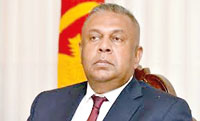 FINANCE MINISTER MANGALA: Speaks his mind in the name of justice In the absence of any comment by the newly appointed Minister of Foreign Affairs Tilak Marapona who, for reasons of his own, had chosen to keep lips zipped on the Rohingya refugee issue, a silver streak lit the night time clouds when the former Foreign Minister of Lanka, now Finance Minister, Mangala Samaraweera stepped into his former shoes and placed his neck on the line and spoke from his heart about the revolting incident a few Buddhist monks staged outside the UNCHR safe house in Mount Lavinia on Tuesday afternoon against 16 children, 7 women and 7 men who had been driven by an ill wind to Lankan shores, seeking refuge from the genocide taking place in their native Myanmar against the race of the Rohingya to which they were born and had no option but to belong. It was brave of Mangala to risk the wrath of the powerful Buddhist renegade army of men camouflaged in saffron. But he spoke for the vast majority of the Buddhists of this country who watched aghast and dwelled in utmost shame how the ‘Sinha-le” monks of the Sinhale Jathika Balamuluwa chapter behaved towards those that needed a Buddhist nation’s compassion and not their hate. Whilst from the voiceless lips of the foreign minister Tilak Marapona – whose brief it is to speak on the government’s stance – there came no word, Mangala rose to the occasion and said: “I condemn in the strongest possible terms the attack against the Rohingya refugees who were under the care of the UNHRC in Mt. Lavinia by a group of ‘thugs in robes’. In fact, I condemn these actions not only as the Minister in charge of Media but also condemn as a Buddhist, a Buddhist who is very proud the fact that Buddhism is a religion of non-violence and compassion,” he said. 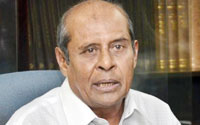 FOREIGN MINISTER TILAK MARAPANA: Silence is golden He said the group of refugees, 30 of them from Myanmar, were rescued at sea by the Sri Lankan Navy in April this year and they were under the care of the UNHRC waiting to be resettled elsewhere in the US or Canada. “In fact this is not the first time Sri Lanka has given temporarily shelter to such refugees. Way back in March 2008, the Navy rescued survivors of a boat after they were found adrift in the high seas. “They were kept here until 2012 the year they were resettled in the US,” he said. And thumbs down, Foreign Minister Tilak Marapona for staying mum; and offering no stroke when the lofted ball was ready to be hit for a six. Perhaps, you let it pass in fear it might strike someone beyond the pavilion tent. But if you cannot stand the heat, perhaps, you should not be in the kitchen.
| |
Tigress Suu turns pussycat and purrs to martial tune 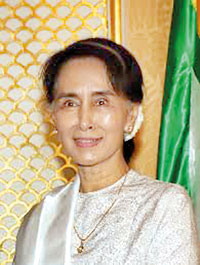 Myanmar’s Living Martyr: Aung takes a knock and a fall from her pedestal Once she was the darling of the western world for her indomitable stance on regaining civilian power from the bayonet of the military gun. They even gave her the Nobel Peace prize for her efforts. She was then the Burmese tigress, who snapped, snarled and scowled and threatened to bring the military junta down, so much so she had to be caged in her house for many years. She is a woman to be admired. For she has sacrificed her personal life in the cause of her country, to wrest its fate from the claws of it military and restore the democracy her people had known before. She was, and perhaps still is, the living Martyr of Myanmar. But from afar, we cannot, and should not, rush to judgment. After a lifelong battle against the military, today she has been taken in, made a member at that high table, honoured and empowered with the title of State Chancellor which means she is Minister of every portfolio and thus the defacto head of Myanmar’s government. But under the thumb of the military high command, of course. They have used her to give legitimacy to martial rule. They have used the face of a civilian as a facade. The face of a beautiful and serene woman who has captured the hearts of millions of her country’s people; and won the applause of the world. But her stunning silence on the Rohingya issue, on the ethnic cleansing campaign launched by the Myanmar military against this helpless minority has served to delete the prefix ‘saint’ before her name and demonstrated even a tigress can end up a pussycat purring to the tune of martial music.
| |


Leave a Reply
Post Comment